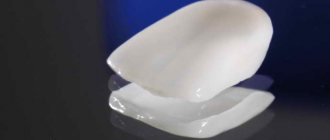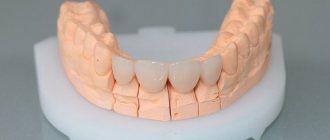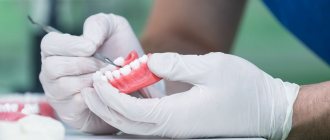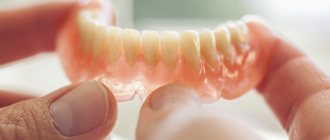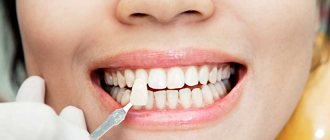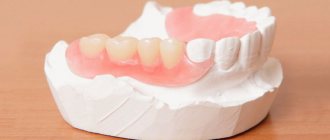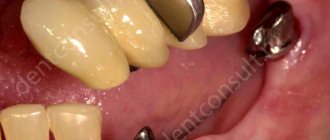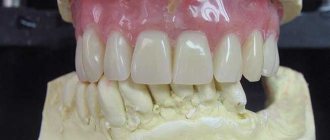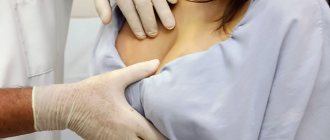Teeth under the reliable support of implants: a guarantee of your peace of mind
Dental implants have become a revolutionary invention in dentistry. They have allowed people all over the world to restore any number of previously lost teeth. The prostheses installed on them are highly comfortable and look as beautiful and natural as possible. They, unlike their removable “brothers,” allow you to return to good nutrition and again experience the taste of your favorite dishes. It is their features, advantages and disadvantages that today’s article will be devoted to.
In what cases is it worth installing a fixed denture on implants?
Regardless of how many teeth a person has lost - one, several, many or all - he should seriously think about ways to restore them. Otherwise, the day is not far when he will no longer enjoy life, complexes will arise about his appearance and problems with self-realization, with communication, and with health.
The negative consequences of loss begin to affect after the need to say goodbye to one element of the dentition, and they are increasingly aggravated with multiple and complete edentia. In this case, they are usually supplemented by an acute deficiency or lack of jaw bone tissue, which gradually begins to decrease in volume as it is no longer needed.
So, in order to prevent this from happening, it is important to find the right and high-quality solution to the problem of edentia. And just the same, removable dentures on implants will be considered the best way to restore smile defects.
Dentures for completely edentulous upper jaw
Up to 8 implants are implanted into the jawbone from above, since the bone here is loose and subject to atrophy (compared to the lower jaw). In some cases, removable prosthetics of the upper jaw are organized on 4-6 implants, if the density and size of the bone allows.
If there is a significant deficiency of bone tissue, there is a risk of injury to the maxillary sinuses, then a sinus lift is performed first or mini-implants are used.
But mini-sized artificial roots are not the best option for fixing removable dentures on the upper jaw. Titanium roots will not stick to loose fabric. If mini-products are implanted, the Locator fixing mechanism is used.
What are the types of fixed dentures?
Fixed dentures are fixed on implants or immediately after implantation of artificial roots, if the patient has chosen one of the one-stage implantation methods, for example, all on six or all on 4 implants for a full dentition. Or after a certain period of time, most often - no earlier than six months after the installation of implants - if it was decided to restore teeth using a two-stage classical treatment protocol. They come in the following types:
- single crowns: they are made and installed when the patient needs to restore one or more lost teeth,
- bridge structures: they can be either partial or complete. They are a prosthesis consisting of only crowns, supported by a different number of supports or implants, minimum - 2 pieces, maximum - 14,
- full or partial structures with acrylic gum: such dentures are especially necessary for people who, before implantation, suffered from inflammation of the mucous membrane and periodontium, for example, periodontitis or periodontal disease. In their composition, they have a beautiful gingival margin, which covers the gums that have undergone pathological changes as a result of gum disease and improves the appearance of the smile. Designs of this type perfectly save people time and money, and allow them to avoid additional gum surgery operations.
Types of attachment of prosthetic structures to implants
There are two options for attaching prostheses to implants implanted into bone tissue. The first one is screw. It allows you to fix the crown of the prosthetic structure and the abutment together using a special screw, which is screwed through the chewing surface of the artificial tooth and then masked with a composite. If necessary, a doctor can always easily and quickly disassemble such a system and make the necessary adjustments.
The second one is cement. It is assumed that the prosthesis is attached to the abutment using a cement adhesive. This type of fastening is used only for permanent restorations, after the doctor is completely sure that the artificial teeth do not need correction, and the tissues around the implant are completely healthy and do not need treatment.
Impression of a standard abutment using the closed tray method
For standard abutment impressions, the closed tray method is used (otherwise known as the indirect method). The impression is made in several stages:
- The former is removed (clinical stage). The doctor uses a hex screwdriver to remove the former. It is important that the implant platform is free of soft tissue. Transfers must be placed one at a time. This will prevent soft tissue from getting on the platform.
- Abutments are placed to secure the screw (clinical stage). The doctor takes a special tool - a hex adapter. With its help, he places abutments. After this, you can additionally fix it with a dynamo key. The abutments will now be in your mouth.
- Transfers are made (clinical stage). The doctor places the transfers manually.
- Preliminary impression taking (clinical stage). The doctor uses a syringe with impression fluid. He carefully sprinkles it around the transfer.
- Full impression taking (clinical stage). Impression fluid is applied to a special dental tray. After this, the spoon is introduced into the oral cavity.
- The formers are returned (clinical stage). After some time, the doctor removes the spoon from the mouth. Then the transfers are removed from the abutments, and the formers are attached back using a hex screwdriver. After this, the resulting result is transferred to the laboratory.
- Before the laboratory stage, there is another clinical stage - changing the location of the temporary prosthesis. The prosthesis is removed from its place, and special substances are placed in its place, which fill the cavity until a permanent prosthesis is made.
- Transfers and abutment analogues are assembled (laboratory stage). Transfers are attached to analogue abutments. After this, they are placed at the appropriate point on the print.
- A full-fledged plaster model is made (laboratory stage). A dental technician uses plaster to cast a working model.
Features of this type of prosthetics
As noted above, fixed dentures are placed on implants when different numbers of teeth need to be restored. Let's consider each case in more detail:
- restoration of one tooth: occurs by implanting one implant into the jaw. If you lost a tooth a long time ago, then most likely before this procedure you will need to build up atrophied bone tissue in the area of loss and undergo a long period of rehabilitation (on average, six months). Next, a single crown made of metal-ceramic or zirconium is attached to the implant - in classic two-stage treatment options, this occurs only after complete healing of the bone tissue and engraftment of the installed implant. But if tooth extraction is just planned, then the patient, bypassing waiting and bone grafting, can immediately install an implant using a one-step implantation method - the doctor will immediately fix a lightweight single crown made of metal-plastic onto it. True, such a crown will be removed from the bite - its length will be slightly shorter than the adjacent teeth. This will avoid unnecessary load on the prosthesis during the rehabilitation period and restore the aesthetics of the smile,
- restoration of several dental units: the procedure requires the implantation of several implants at once (depending on the number of teeth to be restored). After engraftment, a full-fledged bridge, consisting of only crowns, is fixed on them. If the patient, among other things, has lost the shape and beauty of the mucous membrane, gum plastic surgery can be performed additionally, or a slightly different type of construction can be chosen - a bridge with an artificial gum contour. As a rule, for permanent fixed prosthetics, the patient in this case may prefer prostheses made of metal ceramics or zirconium. The second material is more preferable when restoring up to 5 missing teeth in a row - it can withstand significant chewing structures, is very wear-resistant and will ensure a long period of operation of the structures - 20 years or more,
- restoration of teeth with complete edentia: in this case, the situation is often complicated by acute atrophy of bone tissue, inflammation of the mucous membrane, unevenness of the gingival margin, therefore, a prosthesis consisting of crowns alone without prior bone grafting and gum grafting will not be suitable. But the problem will be well solved by a design with a metal base and an artificial acrylic base, which can be installed on the patient immediately after implantation using implantation protocols with immediate loading. These include, for example, all-on-3 methods, prosthetics on 4 or six implants, basal complex, zygomatic implantation for the upper jaw.
Important! With immediate loading methods, the patient has the opportunity to install on the implants either first a temporary structure made of metal-plastic, and after six months, change it to a permanent one made of metal-ceramics or zirconium, or immediately a permanent prosthesis made of ceramic composite, which will not require a re-prosthesis stage and will serve its owner no less a couple of decades.
Orthopedic stage of prosthetics on implants
The final stage is orthopedic treatment. The processes of implant engraftment and soft tissue healing are monitored on x-rays and are usually completed successfully within six months. After this, the patient makes an impression of the jaw using a special impression material. A plaster model with an implant is created, thanks to which the dental technician makes a crown taking into account the individual characteristics of the client. The prosthesis is made according to a certain scheme:
- an impression of the jaw is made taking into account the characteristics of the bite and a template is made;
- a metal base and a wax base for the prosthesis are created;
- The finished structure is tried on and its subsequent cladding is carried out, taking into account the desired shade.
The denture is then fitted to the client. After going through all the stages of prosthetics on implants, it is necessary to regularly see an orthopedic surgeon, monitor the prosthesis in the first stages of use and, if necessary, adjust it.
Calculator: calculate prices online
Crowns on implants
Calculate the cost yourself
Select the type of crown
0
Specify the required number of crowns
+Installation of an abutment on the implant is additionally paid: 1 abutment is required for one crown. The cost of 1 abutment is 4000 rubles.
Better and more accurate - in a free consultation! All addresses and telephone numbers are on the website chudostom.ru. Make an appointment by calling the branch closest to you.
The calculation is not a public offer; the final cost is determined at a free consultation BEFORE the start and does not change during the treatment process.
Total cost rub.
Calculator: calculate prices online
Metal-ceramic crowns and bridges
For an accurate final calculation, the cost of fixation and the cost of impressions are added to each crown once for the entire work; for the intermediate part of the bridge - no fixation is added at the site of missing teeth.
Select the type of metal-ceramics
0
Please indicate the number of crowns and artificial teeth
+There is an additional charge for the fixation of each crown. The cost of 1 fixation is 300 rubles.
+Additionally, there is a one-time fee for the impression. Cost 1500 rub.
Better and more accurate - in a free consultation! All addresses and telephone numbers are on the website chudostom.ru. Make an appointment by calling the branch closest to you.
The calculation is not a public offer; the final cost is determined at a free consultation BEFORE the start and does not change during the treatment process.
Total cost rub.
Calculator: calculate prices online
Metal-free/zirconium crowns and bridges
For an accurate final calculation, the cost of fixation and the cost of impressions are added to each crown once for the entire work; for the intermediate part of the bridge - no fixation is added at the site of missing teeth.
Select the type of crown
0
Specify crowns and artificial teeth
+There is an additional charge for the fixation of each crown. The cost of 1 fixation is 300 rubles.
+Additionally, there is a one-time fee for the impression. Cost 1500 rub.
Better and more accurate - in a free consultation! All addresses and telephone numbers are on the website chudostom.ru. Make an appointment by calling the branch closest to you.
The calculation is not a public offer; the final cost is determined at a free consultation BEFORE the start and does not change during the treatment process.
Total cost rub.
Calculator: calculate prices online
Restoration of the coronal part of the tooth using modern light-curing composites
The price is ALL INCLUSIVE except anesthesia, if necessary
Select the type of restoration
0
Indicate the number of restorations to be made
Advantages and disadvantages of the method
The advantage of fixed prosthetics of one or more missing teeth on implants is the absence of grinding of supporting teeth, which is necessary when restoring a tooth using a conventional bridge. The price of a crown for an implant costs approximately the same as a metal-ceramic bridge prosthesis (after all, you will have to pay for 3 crowns at once). However, in the first case, the adjacent teeth will not be damaged or worn out earlier than expected, the bone tissue of the jaw will not atrophy, and the prosthesis will last much longer.
If we are talking about complete edentia, then, in principle, dentures on implants will give a head start to any removable prosthetics: they are securely fixed in the oral cavity, they involve the jaw bone tissue in their work, they will not fall out at the most inopportune moment and do not require additional adhesives for fixation . In addition, non-removable structures are compact, look very natural, they do not interfere with diction and do not put pressure on the mucous membrane. They do not have a palatal overlap on the upper jaw and will not block your taste buds. The implants will efficiently distribute the chewing load, and the metal component in the prosthesis, with complete edentia, will allow you to eat even foods that were unavailable to you during dental problems - meat, sweets, cookies, apples, toffees. In this case, nothing will happen to the implants themselves or to the prosthesis - no displacement, deformation, frequent corrections, breakdowns, or inconvenience.
As for the disadvantages, there are not so many of them compared to the advantages. The first is the relatively high cost of dental restoration. But taking into account the fact that you will have to adjust removable structures or even a regular fixed bridge for negative changes in the mucous membrane more often than the stated 5 years of operation and inconvenience in general, implant-supported dentures are an excellent contribution to future peace of mind and stability. The second drawback is directly related to the implantation procedure, not prosthetics. It should only be performed by a professional doctor, especially with regard to one-stage methods of dental restoration. Otherwise, there is always a risk of getting a low-quality, short-lived result, and encountering implant rejection and peri-implantitis.
Removable dentures: types
During dental prosthetics, implants act as a supporting surface, and removable dentures are fixed on them. Their advantage is that compared to non-removable structures they are relatively cheap.
- beam structure;
- spherical fixation on implants MIS, Alpha Bio, as well as Nobel and others;
- screw mount, such as All-on-4.
There are three types of methods for attaching removable prosthetics supported by implants:
- Fixation with ball-shaped locks. The top of these structures is a ball, which is the main attachment for new teeth. The second part of the lock is hidden in the artificial gum of the prosthesis. They can also be used to provide additional support for removable dentures.
- Mounting on beams - the technology consists in the fact that several installed implants are combined with each other by one metal beam. A similar design is installed on a removable denture. The connection occurs through snapping, after which the prosthesis is firmly attached to the implants. Such fastening is acceptable if the entire jaw (upper or lower) is replaced with a removable denture. Several implants are installed on the gum (one jaw has 4-6 implants).
- Screw fastening is a technology that allows you to restore the entire dentition without necessarily installing an implant on each tooth. 4 implants act as a support for installing a conditionally removable prosthesis. The fastening in question implies that the crown and adapter will be connected outside the oral cavity. Next comes screwing the structure to the implant using a screw. The screw passes through a through hole located in the chewing surface of the crown. Once the crown is secured to the implant, the hole is closed with a composite made in the same color as the crown. Screw fixation has the following advantages: placement on the implant is carried out with maximum precision, a minimum of technological gaps, if necessary, it is possible to remove the prosthesis. Therefore, such prosthetics is advantageous, since a strong fixation occurs.
Types of prosthesis fastening.
From left to right: screw, spherical, beam Basal dental implantation in 3 days: an alternative to removable dentures! Video review of the patient about implantation in 3 days.
Stages of installation of implants and prostheses
Standard two-stage implantation with delayed installation of fixed structures proceeds according to the following scheme and involves the following stages:
- preparation: taking an anamnesis, excluding medical contraindications, assessing the condition of bone tissue, treating teeth and gums if necessary,
- removal of decayed teeth: if there are such indications, the doctor will first remove the necessary elements of your dentition, and then send you for rehabilitation - you can proceed to implantation only after the sockets have healed,
- bone tissue augmentation: the procedure is necessary if you have had your teeth removed a long time ago. During their absence, the bone tissue has atrophied and is no longer sufficient to install the classic implant model and securely fix it. Also, lack of bone can lead to injury to the sinuses or nerves, because. they are in close proximity to the areas where the structures are being installed,
- implantation: this is a surgical stage in which local anesthesia, anesthesia or sedation is used. The mucous membrane is peeled off and a bed for the implant is created using a special tool. A titanium rod is fixed into the bone tissue, then the gum is sutured. This is followed by osseointegration, when the rod integrates with the jawbone. It can last from four to six months,
- gum former: this stage will help to form a beautiful contour of the mucous membrane around the body of the implant and help achieve the natural beauty of a smile,
- abutment fixation: after complete healing of the rod, the gum is opened and an abutment is installed on the implant. Next, impressions are taken to make the crown. After creating the prosthesis, it is tried on and then attached to the abutment.
Instant implantation is performed somewhat differently. The doctor can simultaneously remove decayed teeth and install implants. The patient may not require bone grafting at all, or the specialist will perform it in conjunction with implantation. Already 1-3 days after installing the artificial roots, the doctor will fix the permanent prosthetic structure and ask you to immediately join the natural process of feeding your new teeth - this will help activate the cells of the jaw bone tissue and recover faster after the procedure.
This method saves your resources: money, time, effort. It is great for those who are missing a large number of teeth, and also have other problems: periodontitis and periodontal disease, diabetes, osteoporosis, craving for smoking, oncology, old age.
How many implants are needed to install dentures?
Full installation - is it possible to replace all teeth with implants?
A titanium rod is placed in place of each lost unit. Up to 14 units must be installed on the upper and lower jaw . Sometimes - 12 (second molars are ignored). After installation, a separate crown is placed on each of them.
Full implantation is the best way to restore teeth from an aesthetic and functional point of view. However, this technique has contraindications - a large number of implants cannot be implanted if the volume of the jaw bone is insufficient.
Number of implants when installing a bridge
This method is identical to classic bridge prosthetics, only the support is not healthy teeth, but titanium rods. Dental product resource quantities may vary. On average, 7–10 are implanted into the lower jaw , and 6–8 into the upper jaw . Installing a fixed bridge is the best option for complete edentia, plus it is cheaper.
Implantation of the upper and lower jaw according to the All-on-4 and All-on-6 protocol
These methods were invented by the Swiss company Nobel Biocare. It is suggested to install a fixed prosthesis in case of loss of all teeth or partial edentia on 4 (with All-on-4 implantation) or 6 implants (with All-on-6 implantation).
Reliability of fastening of the prosthesis is ensured by the special arrangement of the rods - 2 are installed in the anterior part of the dentition, and 2 or 4 on the sides at an angle of 30-45°. Within a few hours after implantation, a permanent temporary prosthesis is installed, which will be replaced with a permanent one in 3-6 months.
“All on Four” and “All on Six” technologies are successfully used in cases of small bone volume, proximity of nerves, and the maxillary sinus.
Removable denture with a minimum number of supports
Removable denture with a beam fixation method.
If it is impossible to implant even 4 implants, a minimum number of dental structures - two or three . Ball-shaped abutments are installed on top of the implants. This allows you to securely fasten the removable denture, and at the same time it is easy to remove for hygienic procedures.
The beam method of fixation is also used. The beam, connecting the prosthesis with the implant, provides a more durable fastening in comparison with spherical abutments and promotes uniform distribution of the chewing load.
Installation of dentures on mini-implants
Implantation using mini implants
Installation of mini-implants when there is insufficient bone volume and it is impossible to build it up. Mini-rods are identical in structure and shape to classic models. The difference is in size, the diameter of standard structures is 3.5-5 mm, length is at least 1.5 cm, mini versions are less than 3.5 mm in diameter, up to 1.4 cm in length. Suitable only for holding removable dentures.
Mini-implants differ in the way they are attached to the orthopedic structure - they have a round head surrounded by a rubber ring. The principle of operation of the fastener is similar to a button on clothing. For attachment it is necessary to insert 4-6 mini-implants.
For implantation, a minimally invasive method is chosen, which significantly reduces the time of implantation, trauma and the rehabilitation period. But mini-implants have a short service life (no more than 10 years).
Rules for caring for new teeth
On a note! Fixed structures on implants should be cared for in the same way as living teeth.
Another plus for fixed dentures on implants: compared to removable ones, for example, they are easier to care for and do not require the additional purchase of special cleaning tablets or solutions. It is only important to follow all the basic rules of oral hygiene and visit the dentist regularly (at least once every six months). An excellent addition to a toothbrush and toothpaste would be special rinsers and irrigators. If necessary, professional ultrasonic cleaning should be carried out.
General characteristics and installation features
The mentioned structure on implants is required in cases where teeth are completely absent or only a small number are retained.
The need to fix dentures to a toothless jaw is due to the fact that the degree of adhesion under such conditions is very low. Over time, it becomes more and more difficult to fix the prosthesis, which is associated with the gradual atrophy of the bone tissue that is located under it.
The prosthesis is connected to the implant by a locking mechanism, one structural part of which is located in the prosthesis, and the other on the installation surface.
When putting on the prosthesis, the locks snap into place, which allows you to firmly fix it in the oral cavity.
Reference! The most commonly used materials for the manufacture of implant prostheses are ceramics and acrylic.
This method is called conditionally removable prosthetics. This is due to the fact that a person who has prostheses installed on implants cannot remove them on his own, but if this is required for some reason, such an action can be performed by a specialist.
What is a conditionally removable prosthesis:
Cost of treatment
Prices for fixed types of prostheses on implants differ. They depend on the amount of work, the material used and the degree of complexity of the installation procedure.
High-quality crowns cost on average from 18 to 50 thousand rubles for single restorations. When installing a prosthesis on implants, you will also need to pay for the implantation procedure and the implant itself - the average cost ranges from 30 to 80 thousand rubles.
If we are talking about patients with complete edentia, then the best prices will definitely be for complex offers. For example, the minimum number of implants installed, 4 pieces, and a fixed prosthesis for the entire jaw will cost approximately 300-320 thousand rubles. If you restore both jaws, you can spend 500 thousand rubles. Of course, prosthetics for a completely toothless mouth can be performed using classical implantation, but here, get ready to say goodbye to at least a million rubles.
